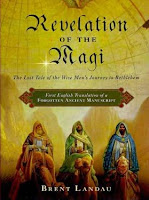Oklahoma
has been hiding one of its most interesting secrets for two years,
namely its very own Syriac scholar. Dr. Brent Landau, graduate of
Harvard Divinity School, is Assistant Professor at
University of Oklahoma's Religious Studies Program.
Dr.
Landau is noted for providing the first English translation of what
has been named the "Revelation of the Magi", a Christian apocryphal
work and the most extensive Magi account from the ancient world. The
Syriac narrative is preserved in a longer work comprising
Vaticanus Syriacus 162, a codex housed in the Vatican Library.
Landau
estimates the original "Revelation of the Magi" (ROM) was composed in
the late second or early third century and was written from the
perspective of the Magi themselves. It was then redacted in the third or
fourth century to include the Apostle Thomas in a third-person
account. The Vatican manuscript used by Landau for his English
translation is from the 8th century.
With the Nativity approaching it is no accident that Harper Collins has released Landau's research entitled
Revelation of the Magi: The Lost Tale of the Wise Men’s Journey to Bethlehem,
based on his dissertation and edited for the wider audience in mind.
The press releases and articles begin with the usual dramatic titles
about lost scrolls and Christian origins. My favorite is...
.jpg)
This
ancient text sheds light on an aspect of the Nativity often taken for
granted. Yet the ROM in no way stamps "solved" upon the story of the
Wise Men. Just the opposite, it (happily for bibliophiles) raises more
questions and suggests relationships with early Christian hymnody and
other sources.
ROM is well-crafted and the narrative
includes some intriguing points of interest such as; the Magi never
refer to Christ by name, their food supplied by Providence appears to
have hallucinogenic qualities (or at least that is how it might be
described in modern terms), and the original author linguistically
equates the Wise Men's title "Magi" with "silent prayer" in some
unknown language.
Among the more surprising aspects is
the notion that the star of Bethlehem followed by the Magi is far more
than an astronomical event. Landau points out the star is actually the
pre-existent Christ himself, "a literal representation of St. John's
'light of the world'”. The Johannine connection is certainly a strong
one from our 21st century point of view. But when we also take into
account the magi/silent prayer connection, the star-as-Christ motif
seems to imply that the account is more than just legend and perhaps
set within a larger theological context.
Landau
recognizes within ROM similarities with Syriac baptismal hymns. I
wonder if more light can be shed on these mysterious aspects if it were
compared to other existing liturgical material. I cannot immediately
recall if the Magi are mentioned in
On the Mother of God by Jacob of Serug (trans. Mary Hansbury). If so, it might prove to be an interesting comparison.
If
you are interested in seeing the Syriac text (nicely vocalized) and a
more technical treatment of the ROM, Landau's dissertation can be
downloaded
here at Academia.com.
A critical edition will be available to the scholarly community when Landau publishes the Syriac text as part of
Brepol's Corpus Christianorum Series Apocryphorum.
What
does ROM's complex portrayal of the Wise Men tell us about early
Christianity or at least about the Nativity itself? The appearance of
the star-Child to the Magi is a clear statement of Christ's ability to
reveal Himself to whomever He chooses. In other words, evangelization by
humans is not always a necessary endeavor. ROM suggests the
possibility that this revelation may be "but one of potentially many
instances in which Christ has appeared to the people of the world".
Indeed this is supported by the Acts of the Apostles. Beyond this,
Landau proposes a more universal message, that the "revelatory activity
of Christ as the primal cause of humanity’s religious difference." In
other words, Christ could reveal himself in the person of Buddha,
Mohammed, or as any religious identity.

Even
with ROM's atypical treatment of Christ, the concept of a revelation
within other religions brought to mind the ancient and ubiquitous
"Christ Pantokrator" icon which, like all icons, communicated Christian
belief through visual imagery. Not necessarily a triumphalist symbol,
Christ Pantokrator suggests
that the various religious traditions are echoes of the truth, and
Christ, with His unending love for all humankind will at any time
abruptly appear in time and space to anyone for the purpose of
affirming His
identity, as opposed to equating it to all other iconic identities
within the world's religious milieu. A traditional perspective doesn't
necessitate that other religions are always antagonistic.
Though
the message of the Magi as presented by Brent Landau is more
ecumenical than many traditional Christians would be comfortable with,
he treats conservative Christian beliefs with great respect and
sensitivity both on paper and in person. I hope Brent Landau's expertise
will be valued and sought out in a state where Christianity is so
predominant.
I generally do not purchase pop culture
books written by biblical scholars. But in this case I made an
exception and was happy to do so, and for several reasons: it is a work
by a recognized Syriac scholar in Oklahoma (the only one) and as an
Oklahoman, I am intensely proud of this. Secondly, one gets the
impression that the full value of ROM is yet to be discovered. The real
story of the Magi will continue to unfold.


.jpg)





